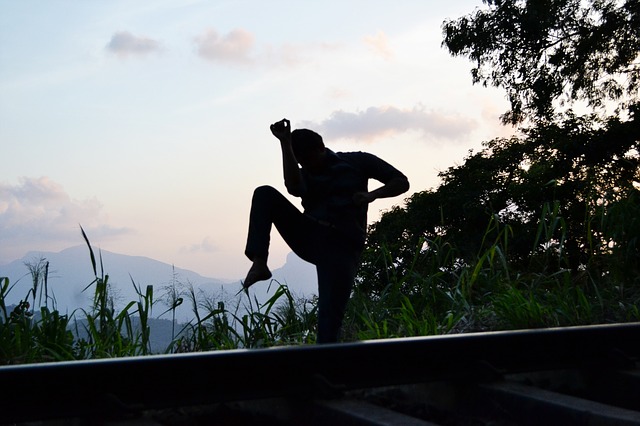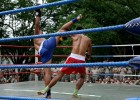Defending Techniques used Throughout Muay Thai
Learning defence techniques throughout your Muay Thai training in order to use them effectively throughout any Muay Thai fight is one of the most important aspects of any Muay Thai journey. Originating in Thailand several years ago as a way to utilize the entire body as a weapon during the close contact combat of ancient war, Muay Thai is a unique Mixed Martial Art that employs six main categories of defensive techniques in order to overpower and win against your opponent.

Like many other Mixed Martial Arts, Muay Thai uses a range of various techniques and methods from its own ancient origins and other sports such as Kickboxing to create a dynamic fusion of style, that is not only effective against opponents in professional and unprofessional fights, but also powerful in the ability to utilize your entire body and its ailments as a weapon during any time of conflict. This style of fighting was essential throughout Thailand during the origin years of Muay Thai, making it a close contact, fast paced Mixed Martial Art that is still true to its heritage today.
Learning the defence techniques in Muay Thai is a key component to any successful Muay Thai training, and like other factors you will come across in Muay Thai training, the difficulty of defence techniques and the way in which they protect you from attack by your opponent and subsequently allow for more advanced counter-strikes, will increase as time goes on and both your training and experience level increases.
Throughout Muay Thai, the concept of the ‘Wall of Defence’ will be used during any of the main categories of Muay Thai defence techniques. The ‘Wall of Defence’ concept uses the shoulders, arms and legs to hinder your attacker from successfully executing striking techniques, by using these three elements of your body to block attacks and counter-strike against them. Defence techniques and blocking techniques are one of the main aspects and skills any Muay Thai fighter should possess in order to succeed in their Muay Thai training.
Whilst different style striking techniques including punches and kicks, are all Muay Thai techniques designed to take down and overpower your opponent, defence techniques, when executed correctly and accurately can also have as much as an effect on an opponent as a striking technique. Counter-strikes and pre-emptive strikes are all part of the Muay Thai defence technique catalogue and whilst these techniques can protect you throughout any Muay Thai fight, they can also work in your favour, using your opponents weight to inflict damage against them.
Muay Thai as a Martial Art form is one that utilizes its defensive techniques as much as offence techniques, and sometimes the best defence techniques can be that of offensive methodology and vice versa within Muay Thai fights. This style of learning and fighting is one that is fast paced, intense and fast, requiring that fighters have quick reactions, impeccable timing, swift movements and light, but strong body mass for easy mobility around the fighting ring.
One of the key learning curves that any Muay Thai fighter has to go through in order to succeed within their training when learning defence techniques is how to deflect potential attacks fleetly, precisely and of impeccable timing. Muay Thai as a close contact fighting sport is intense and as such, can be physically draining, which is why it is important Muay Thai fighters learn how to deflect attacks and apply attacks using as little energy as possible, returning to fighting position quickly and efficiently. Not only do defence techniques require, swift, prompt movement but Muay Thai fighters also have to learn how to defend themselves precisely and of impeccable timing in order to counter-strike effectively against their opponent and then consequently, use the opponents weight against them to then inflict friendly damage.
As Muay Thai is a varied sport with a vast range of both striking and defensive techniques, the defensive techniques have been placed into six categories in order to establish the role of each and its effectiveness against your opponent and yourself as a form of protection.
These six categories include blocking, redirection, avoidance, evasion, disruption and anticipation. All Muay Thai fighters whether they have learned traditional, authentic Muay Thai or more modern fighters that have learned Muay Thai in more Western countries, will learn the techniques used in each of these six categories, and learn to employ them against an opponent for maximum protection and power.
The first category of six, blocking is a simple category that is defined by its name, applying simple blocking techniques against your opponents incoming strikes to defend and prevent injury to yourself. Simple blocking techniques include shin blocks, arm blocks and the ‘Wall of Defence’ using all three elements as described afore, to block incoming attacks from opponents.
The second defence category used by Muay Thai fighters is redirection, techniques used in redirection defence range from a downwards tap to a jab to ensure an opponents attack misses its target, to using the fighters own arms, shins and other body parts to change the direction of any attacks from your opponent. Whilst these techniques seem simple in idea, they require impeccable timing, precision and skill from the Muay Thai fighter, gained from repetitive practice and training.
The third category of defence techniques employed throughout Muay Thai include avoidance techniques where fighters simply move a body part away from any incoming attack and move another body part in range to apply a counter-strike, ultimately weakening their opponent. Avoidance techniques are vast throughout Muay Thai training and can range from roundhouse kicks, side kicks to punches and knee strikes.
One of the more simpler groups of Muay Thai defence techniques are the methods used in the evasion category. As the name suggests, this style of defence technique moves a fighter out of the way of any incoming strikes from their opponent. Whilst this is one of the easiest defence techniques throughout the wealth of Muay Thai training, it is also a technique that expends a lot of energy, as once the fighter has moved out of the range of the opponents attack, the fighter then has to move back into the range of the opponent in order to execute a counter-strike or individual strike against that opponent.
The penultimate defence category of techniques used throughout Muay Thai are disruption techniques. These techniques are some of the more advanced methods more experienced Muay Thai fighters will apply and include mainly pre-emptive techniques that will disrupt an opponents strike as it happens or before it happens, then allowing for counter-strike techniques or strikes whilst your opponent is disrupted and off guard.
The final defence technique category is anticipation techniques, these techniques again, are for the more advanced Muay Thai fighters and require impeccable timing, precision and skill in order to execute correctly and to the advantage to the fighter himself. Anticipation techniques include techniques such as catching an opponents incoming strike and countering it before it can hit its target, or countering opponents attacks before they happen with pre-emptive techniques and precision timing.
These technique categories are all only snapshots of some of the defence techniques used throughout Muay Thai fighting making them staple techniques to learn in order to succeed in any Muay Thai training experience. Whilst defence techniques will vary throughout the Muay Thai training regime, these techniques will increase in difficulty in time, alongside your own personal ability level, confidence and experience. Many professional Muay Thai fighters have been dedicated to the Mixed Martial Art for considerable periods of time and so whilst these techniques could be daunting to newcomers to the art, they are techniques that become more intense throughout time and at the beginning of any new Muay Thai training, only basic defending techniques such as evasion and blocking would be used.
The key principle to Muay Thai as a fast paced Mixed Martial Art requires that fighters have years of training before stepping into the fighting ring. Defensive training strategies such as sparring, Thai Pad work with instructors and practice, all play an elementary role in succeeding as a Muay Thai fighter and whilst these defensive and offensive techniques can take years to perfect, they are established within the Martial Art community as effective techniques for close contact fighting or close-combat war.


